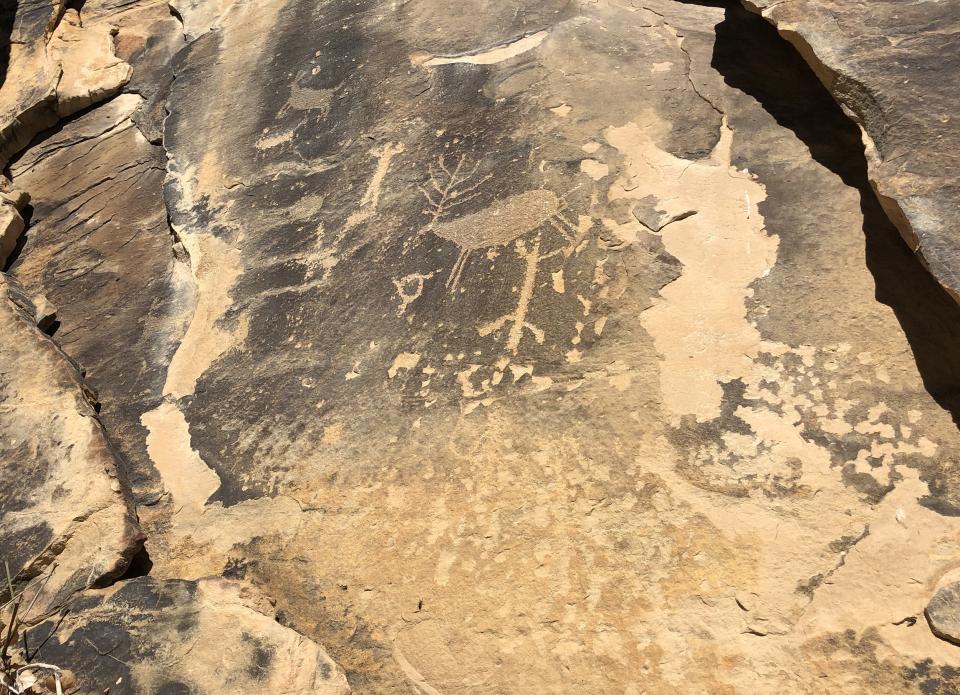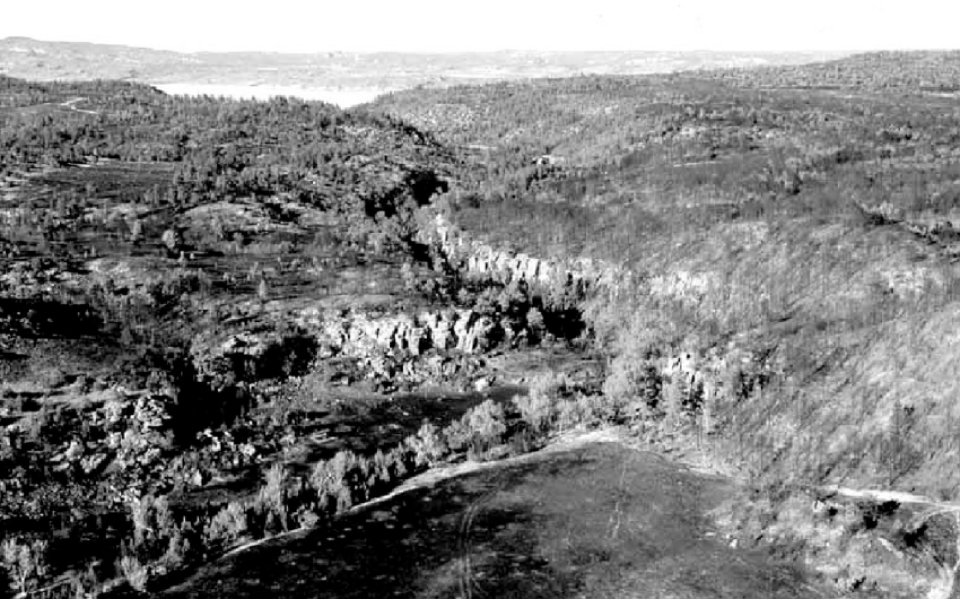- Home
- Encyclopedia
- The Rock Art of Whoopup Canyon
The Rock Art of Whoopup Canyon
Whoopup Canyon, an extensive system of roughly 150 rock art panels along a four-mile-long stretch of Dakota sandstone in northeast Wyoming, is a special place. Its petroglyphs are among the most extensive and among the oldest in North America. Most of the panels are on land in Weston County owned by the LAK Ranch and on public lands administered by the U.S. Bureau of Land Management Newcastle Field Office. The mysteries of Whoopup have endured through the ages.
Defining rock art
The rock art of ancient people can help define and identify different cultural groups, as it shows what people considered important. Panels at Whoopup contain information about prehistoric cultures, including hunting methods and religious practices. Hunting with snare or large game nets, for example, are evident in the images, yet they cannot be studied through traditional archaeological methods such as excavations as the practices leave no material traces.1
Archaeologists refer to markings, painting, etchings and carvings made on cliffs and in caves as rock art. The term pictographs generally refers to painted rock art. Petroglyphs refers to carved rock art which is incised, ground, scratched or pecked. A pictograph or painting is made by adding pigment to the rock surface, whereas a petroglyph results from the removal of some of the rock surface.2 Pecking and incising are the two prominent methods that were used in creating the petroglyphs at Whoopup.
Images and dating
Many of the images on the rock faces are of Black Hills animals including elk, deer, antelope, bighorn sheep, canines, eagles and bison. Human figures engaged in ceremonial and hunting activities are also present. No extinct species or equines are evident.
Lighting is critical when viewing the panels. One can view a panel in the morning and think that it has revealed itself in its entirety. But a return to the same panel in the afternoon often tells a new story as a previously unseen glyph becomes evident.
A thin, dark layer of minerals, visible on the cliffs of the canyon, is key to determining dates on the glyphs. Known as rock varnish, it gradually accumulates on exposed rock surfaces of the Dakota sandstone. Cutting or pecking through an existing layer of varnish resets the rock varnish “clock” for the exposed surface. Carbon-14 and cation-ratio dating from samples of the varnish coating on many of the panels has indicated that the petroglyphs range in age from 2,500 to 11,500 years old. (Cation-ratio dating is based on the fact that the ratio of calcium and potassium ions to titanium in the varnish declines at a predictable rate over time.)
These dates are predominantly correlated with the pecked glyphs, while the incised (scratched) glyphs are younger. Damage from chalking of the glyphs has made it difficult to get accurate dates on some of the rock art. The chalking, while intending to help for photography purposes, leaves residue which interferes with dating methods. It is estimated that nearly 97% of the glyphs at Whoopup have been chalked.3
Panels are located in both upper and lower Whoopup Canyon, but few petroglyphs have been located between the two places. This stretch of canyon is rarely traveled and is virtually impassable except by walking. Though difficult for humans to traverse, the canyon has been used as a game trail for thousands of years, probably as a migratory corridor.
Habitation sites, and studies
There are habitation sites on the ridgetops overlooking the canyons, which shed light onto the occupation of the area. These sites are comprised of small scatters of chipped stone artifacts and some stone circles. These locations are likely associated with the rock art in the canyon and are probably of a comparable age.
Whoopup was of course known to Native Americans for thousands of years, but it wasn’t until the 1930s that the first scientific surveys were conducted. At that time, Ralph I. Olinger—Lusk businessman, Wyoming Legislature representative and amateur archaeologist—provided drawings and wrote to University of Denver anthropology professor Etienne B. Renaud detailing his visit to “Whoop-up Canon.”
Olinger noted of the petroglyphs: “The deer and elk are mostly pictured, but there are mountain goats, antelope, bison, and a few other animals. There seems to be none of horses.” Olinger would also note the “zoomorphic figures are made by fine and deep pecking and are pecked all over the body of the animals represented.”4 The Olinger account appears to be the first documented field study of Whoopup in historical times.
Following Olinger’s rediscovery of the Whoopup petroglyphs, W.H. Over, University of South Dakota Museum director, conducted field work on the lower Whoopup petroglyph system in July 1939. This expedition’s primary work was to excavate a cave thereafter known as “Shuck’s Cave,” in honor of the owner of the land, Arden Shuck. Excavation of the cave revealed little evidence of habitation until a small amount of charcoal and ashes were found at the original base of the cave.
Two projectile points, two broken knives and one bone awl were found. In addition, three pairs of manos (the smaller, rounded stones) and metates (the larger, flat stones) used to grind grains and seeds were found on the floor of the entrance. The University of South Dakota Museum of Vermillion, South Dakota, published numerous drawings of the surrounding petroglyphs in their book by Over, Indian Picture Writing In South Dakota.5
A Rapid City-area farmer, entrepreneur and historian, Charles Haas, performed further research on Oct. 12 and Nov. 15, 1942. Hass, with assistance from the Shuck family, conducted his summer of ’42 studies primarily in the lower end of Whoopup. Haas took many photos of the southern panels and dated the rock art to the “Post-Glacial Period, perhaps 10,000 yrs ago.” Haas’s estimate of the dates is comparable to the dates that have since been acquired using modern techniques. Unfortunately, Haas appears to have chalked many of the rock panels to enhance the images for photographic purposes.6
Preservation
Preserving Whoopup is of the utmost importance. Potential damage to the panels from wildfires has continued to be a growing concern. Due to the decades-long legacy of damage to the rock art, in 1997 the Department of the Interior called an emergency closure of Whoopup Canyon to all uses except the scientific and sociocultural.
To complicate matters, the canyon had begun to be advertised as a rock-climbing venue via the new World Wide Web. Presently, the site remains open only for supervised guided education tours, researchers investigating the site under a cultural resource research permit and Native Americans requesting access for traditional religious use.
NOTES
1 Storied Stone. Indian Rock Art of the Black Hills County. Linea Sundstrom. Norman: University of Oklahoma Press. 2004.
2 Ibid.
3 “Whoopup Canyon Petroglyph Site.” Alice Tratebas. 2002
4 The Archeological Survey of the High Western Plains. University of Denver. Eighth Report. E.B. Renaud. September 1936.
5 Indian Picture Writing In South Dakota. Archaeological Studies Circular IV. W.H. Over. University of South Dakota. 1941.
6 “Black Hills Hieroglyphs.” Chas. C. Haas. 1942. Marice Shuck Hinsdale Collection.
[Editors’ note: Special thanks to the Wyoming Cultural Trust Fund, support from which in part made publication of this article possible.]
Resources
Primary Sources
- Haas, Chas. C. “Black Hills Hieroglyphs.” 1942. Marice Shuck Hinsdale Collection. Gillette, Wyoming.
- Over, W.H. Indian Picture Writing In South Dakota. Archaeological Studies Circular IV. Vermillion: University of South Dakota. 1941.
- Renaud, E.B. The Archaeological Survey of the High Western Plains: Eighth Report: Pictographs and Petroglyphs of the High Western Plains, M015.05.0002.0046.00004. Etienne B. Renaud Papers, M015, September 1936. Special Collections and Archives, University of Denver, accessed September 26, 2024 at https://duarchives.coalliance.org/repositories/2/archival_objects/78180.
Secondary Sources
- Sundstrom, Linea. Storied Stone. Indian Rock Art of the Black Hills Country. Norman: University of Oklahoma Press, 2004.
- Tratebas, Alice. “Whoopup Canyon Petroglyph Site.” 2002. Anna Miller Museum.
Illustrations
- The two photos of rock art are from the author’s collection. Used with permission and thanks.
- The black and white photo of Whoopup Canyon is from a 2004 paper on the effect of fire on rock art, by Alice Tratebas, Nicole Villa Cerveny and Ronald Dorn. Used with thanks.


